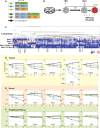A direct fate exclusion mechanism by Sonic hedgehog-regulated transcriptional repressors
- PMID: 26293298
- PMCID: PMC4631756
- DOI: 10.1242/dev.124636
A direct fate exclusion mechanism by Sonic hedgehog-regulated transcriptional repressors
Abstract
Sonic hedgehog (Shh) signaling patterns the vertebrate spinal cord by activating a group of transcriptional repressors in distinct neural progenitors of somatic motor neuron and interneuron subtypes. To identify the action of this network, we performed a genome-wide analysis of the regulatory actions of three key ventral determinants in mammalian neural tube patterning: Nkx2.2, Nkx6.1 and Olig2. Previous studies have demonstrated that each factor acts predominantly as a transcriptional repressor, at least in part, to inhibit alternative progenitor fate choices. Here, we reveal broad and direct repression of multiple alternative fates as a general mechanism of repressor action. Additionally, the repressor network targets multiple Shh signaling components providing negative feedback to ongoing Shh signaling. Analysis of chromatin organization around Nkx2.2-, Nkx6.1- and Olig2-bound regions, together with co-analysis of engagement of the transcriptional activator Sox2, indicate that repressors bind to, and probably modulate the action of, neural enhancers. Together, the data suggest a model for neural progenitor specification downstream of Shh signaling, in which Nkx2.2 and Olig2 direct repression of alternative neural progenitor fate determinants, an action augmented by the overlapping activity of Nkx6.1 in each cell type. Integration of repressor and activator inputs, notably activator inputs mediated by Sox2, is probably a key mechanism in achieving cell type-specific transcriptional outcomes in mammalian neural progenitor fate specification.
Keywords: Fate specification; Mouse; Neural development; Transcriptional regulation.
© 2015. Published by The Company of Biologists Ltd.
Figures




References
Publication types
MeSH terms
Substances
Grants and funding
LinkOut - more resources
Full Text Sources
Other Literature Sources
Molecular Biology Databases

